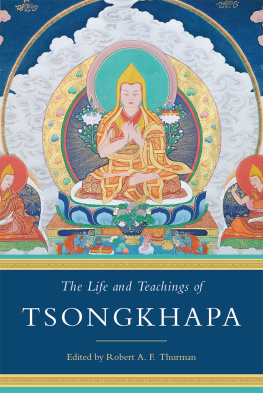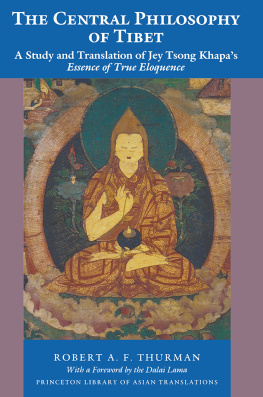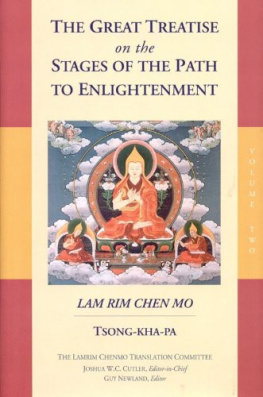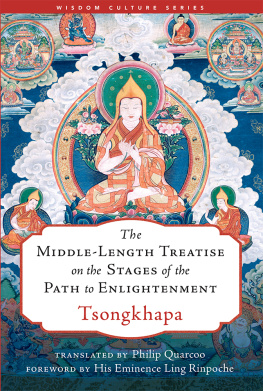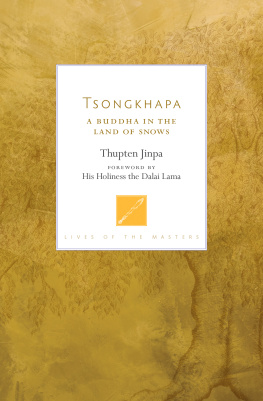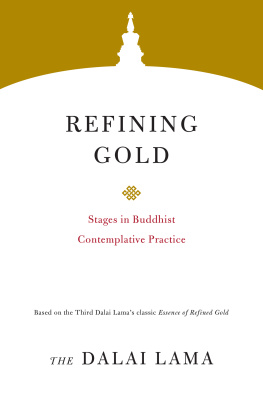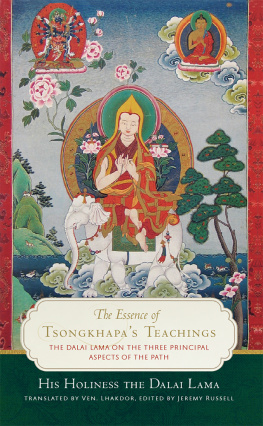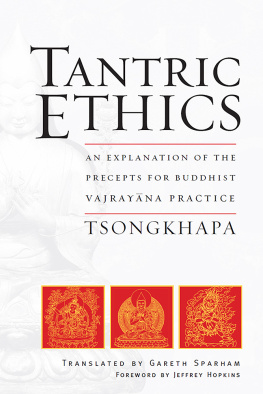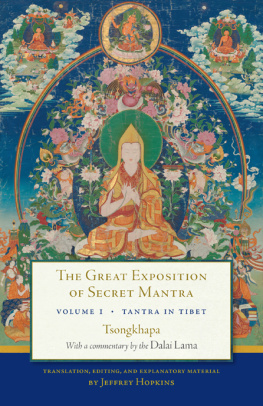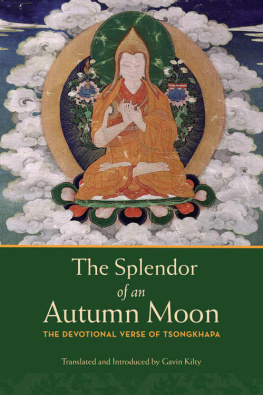
Wisdom Publications
199 Elm Street
Somerville, MA 02144 USA
wisdompubs.org
2018 by Robert Thurman/LTWA, published by Wisdom Publications in collaboration with LTWA. First LTWA edition published in 1982.
All rights reserved.
No part of this book may be reproduced in any form or by any means, electronic or mechanical, including photography, recording, or by any information storage and retrieval system or technologies now known or later developed, without permission in writing from the publisher.
Library of Congress Cataloging-in-Publication Data
Names: Thurman, Robert A. F., editor, writer of introduction. | Sherpa Tulku. | Khamlung Tulku. | Berzin, Alexander. | Landaw, Jonathan. | Mullin, Glenn H. | Tsong-kha-pa Blo-bzang-grags-pa, 13571419. Works. Selections. English.
Title: The life and teachings of Tsongkhapa / edited by Robert A.F. Thurman; translations by Sherpa Tulku, Khamlung Tulku, Alexander Berzin, Jonathan Landaw, Glenn H. Mullin, Robert A.F. Thurman.
Other titles: Life and teachings of Tsong-khapa
Description: [Revised edition]. | Somerville, MA: Wisdom Publications, 2018. | Includes bibliographical references. |
Identifiers: LCCN 2017048509 (print) | LCCN 2017058805 (ebook) | ISBN 9781614294399 (e-book) | ISBN 9781614294276 (paperback)
Subjects: LCSH: Dge-lugs-pa (Sect) Doctrines Early works to 1800. | Tsong-kha-pa Blo-bzang-grags-pa, 13571419. | Dge-lugs-pa lamas Tibet Region Biography. | BISAC: PHILOSOPHY / Buddhist. | PHILOSOPHY / Eastern. | RELIGION / Buddhism / Tibetan.
Classification: LCC BQ7950.T753 (ebook) | LCC BQ7950.T753 E5 2018 (print) | DDC 181/.043 dc23
LC record available at https://lccn.loc.gov/2017048509
ISBN 978-1-61429-427-6 ebook ISBN 978-1-61429-439-9
22 21 20 19 18 5 4 3 2 1
Cover design by Tim Holtz. Interior design by Partners Composition.
Reverence to the Guru, Majughoha!

Preface

S ince the opening of the Library of Tibetan Works & Archives in the 1970s, a number of Tibetan texts have been translated by our Research and Translation Bureau and brought out in print as part of our publishing program. Several of these were by or centered on the life of Lama Tsongkhapa (13571419), an important teacher who had been born in eastern Tibet and later spent many years traveling from one monastery or hermitage to another in search of the various lineages of the Buddhist teachings. His studies and practice explored the full range of Prtimokhayna, Mahyna, and Vajrayna teachings as found in all the schools of Buddhism then extant in the Land of Snow Mountains.
Studying with almost four dozen masters from all traditions of Tibetan Buddhism, the order he established was in fact the first major attempt at combining all Buddhist lineages in Tibet. One could say that the Gandenpa, New Kadampa, and eventually Gelukpa order taught the first appearance of the curriculum of what might be called indigenous Tibetan Buddhism. The earlier traditions in existence at the time were mainly rooted in the teachings of specific Indian masters, such as Padmasambhava for the Nyingma, Virpa for the Sakya, Tilop and Narop for the Kagy, and so forth, whereas Tsongkhapas tradition represented a synthesis of the several dozen most important schools of early-fourteenth-century Tibetan Buddhism. The eighteen volumes of writings that had issued forth from his pen were to act as a major inspiration in Tibetan cultural history, ushering in a renaissance of religious prose and poetry. The resulting effects on art, architecture, and folk culture were a natural product of his creating festivals such as the Great Prayer Festival of Lhasa and of the numerous master artists and craftsmen he used in his building and restoration work, as mentioned below in A Short Biography.
In the spring of 1979 Prof. Robert Thurman of Amherst College, Massachusetts, visited Dharamsl on a sabbatical. Prof. Thurman is indeed one of the Western worlds foremost scholars on the life and works of Lama Tsongkhapa, and the LTWA was most pleased when Prof. Thurman kindly agreed to collect together the various monographs by or related to Tsongkhapa that the LTWA had previously published in English translation, and to complement these with any of his own works that were unpublished.
The text of A Short Biography is based on an oral teaching by Gesh Ngawang Dharg as translated by Khamlung Tulku and Sherpa Tulku, compiled by John Marshall and edited by India Stevens. It has been revised and reedited for this publication by Michael Richards and Kevin Garratt. It was first published by the LTWA in 1975 as A Short Biography and Letter of Jey Tzong-ka-pa.
Song of the Mystic Experiences of the first section of this anthology, as well as the first three items in part 5, were translated by Glenn H. Mullin and Losang N. Tsonawa in accordance with the commentaries of Gesh Ngawang Dharg, Gen Sonam Rinchen, and Gesh Losang Tenpa. They were first published by the LTWA in 1978 as Four Songs to Jey Rinpoche.
Lines of Experience, A Letter of Practical Advice on Sutra and Tantra, and The Prayer of the Virtuous Beginning, Middle, and End were translated by the team of Sherpa Tulku, Khamlung Tulku, Alexander Berzin, and Jonathan Landaw in accordance with the commentary of Gesh Ngawang Dharg. The first of these was originally published as a monograph by the LTWA in 1973 and then reprinted in 1974 in a revised edition. The second originally appeared under the title The Graded Course to Enlightenment (New Delhi: Statesman Press, 1971) and in a revised edition under the title A Brief Exposition of the Main Points of the Graded Sutra and Tantra Course to Enlightenment, in A Short Biography and Letter of Jey Tzong-ka-pa (Dharamsl: LTWA, 1975), with reprintings in 1975 and 1976. For this, their third edition, all three of these works have been retranslated by Alexander Berzin, with the assistance of Ven. Amchok Rinpoche, librarian at the LTWA, in A Letter of Practical Advice on Sutra and Tantra.
The remaining pieces in the collection have all been translated by Prof. Thurman, some in the earlier years of his work with Tibetan literature and some notably the Garland of Supremely Healing Nectars specifically for this collection. The Library is most appreciative of the spirit of thoroughness with which Prof. Thurman approached the subject.
Although Lama Tsongkhapa is one of the most important figures in Tibetan religious and philosophical history, very little material by or about him has appeared in English to date. It is hoped that this small effort will contribute in some way to the Western worlds growing knowledge of Tibet, her culture, philosophy, and religion, and the figures of Tibets past who inspired and influenced the trends of Tibetan thought.
Gyatso Tsering
Director, LTWA, October 1981
Introduction

T his anthology of some of the important works of the great Dharma master Tsongkhapa Losang Drakpa (13571419) is presented for the general reader and the practitioner of the Buddha teachings to give her or him an introduction to the transformative life and profound teachings of that great lama. Most of the translations contained here were done some time ago and published as booklets and xerox manuscripts. Mr. Gyatso Tsering requested me to gather these translations together, adding some explanatory notes and translating newly some special pieces that round out the collection. It was decided from the beginning not to attempt to impose any standard terminology or even transliteration system on the works done by different translators, leaving each with his own style and taste. The key purpose of the anthology is to grant access to the useful teachings, the greatness of which always goes back to the greatness of the teacher. Tsongkhapa himself begins his
Next page
